The Intel Broadwell Xeon E3 v4 Review: 95W, 65W and 35W with eDRAM
by Ian Cutress on August 26, 2015 9:00 AM ESTOffice Performance
Dolphin Benchmark: link
Many emulators are often bound by single thread CPU performance, and general reports tended to suggest that Haswell provided a significant boost to emulator performance. This benchmark runs a Wii program that raytraces a complex 3D scene inside the Dolphin Wii emulator. Performance on this benchmark is a good proxy of the speed of Dolphin CPU emulation, which is an intensive single core task using most aspects of a CPU. Results are given in minutes, where the Wii itself scores 17.53 minutes.

Dolphin prefers single threaded speed and IPC, which the extra frequency of the v3 wins out here. The disparity between the 65W/95W v4 processors and the 35W processor is most obvious here.
WinRAR 5.0.1: link
Our WinRAR test from 2013 is updated to the latest version of WinRAR at the start of 2014. We compress a set of 2867 files across 320 folders totaling 1.52 GB in size – 95% of these files are small typical website files, and the rest (90% of the size) are small 30 second 720p videos.
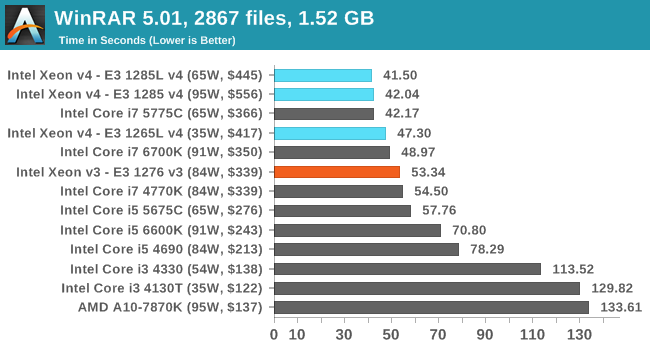
WinRAR is our classic 'eDRAM works here!' benchmark, clearly showing how Broadwell benefits. Although, one might argue that WinRAR is not a typical workload environment. It is also poignant to show that the 95W v4 doesn't win here in this variable-threaded load.
3D Particle Movement
3DPM is a self-penned benchmark, taking basic 3D movement algorithms used in Brownian Motion simulations and testing them for speed. High floating point performance, MHz and IPC wins in the single thread version, whereas the multithread version has to handle the threads and loves more cores.
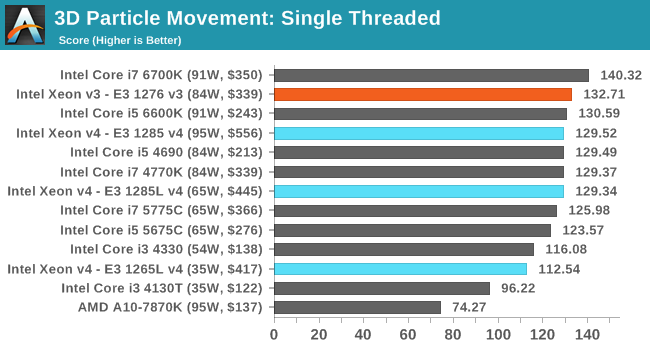

Similar to CineBench, in single threaded mode the v3 wins out due to the faster frequency, but in multithreaded mode the advancements in the Broadwell core due to better thread resource management puts at least the 95W v4 ahead.
FastStone Image Viewer 4.9
FastStone is the program I use to perform quick or bulk actions on images, such as resizing, adjusting for color and cropping. In our test we take a series of 170 images in various sizes and formats and convert them all into 640x480 .gif files, maintaining the aspect ratio. FastStone does not use multithreading for this test, and results are given in seconds.
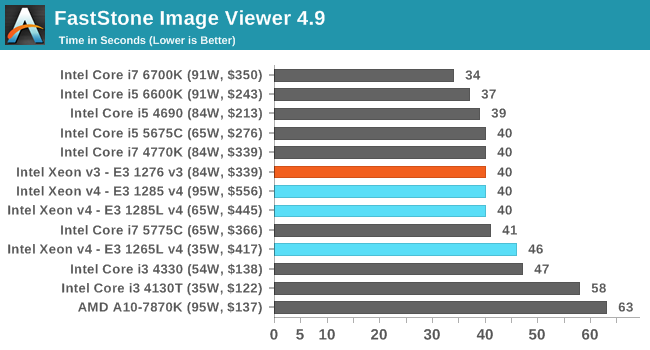
Web Benchmarks
On the lower end processors, general usability is a big factor of experience, especially as we move into the HTML5 era of web browsing. For our web benchmarks, we take four well known tests with Chrome 35 as a consistent browser.
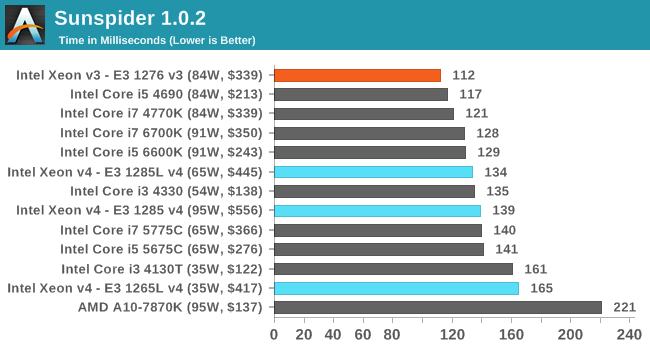
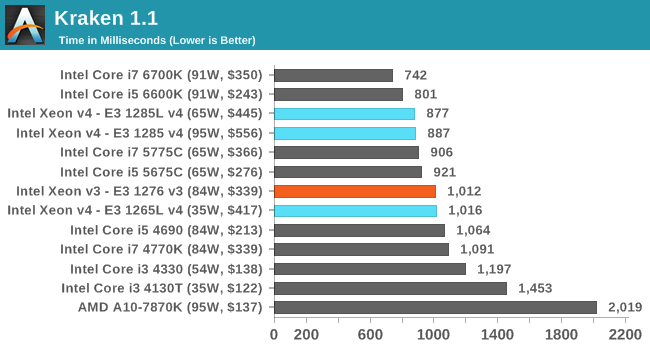
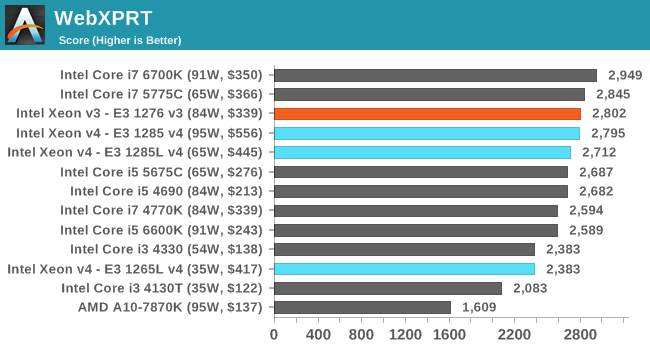
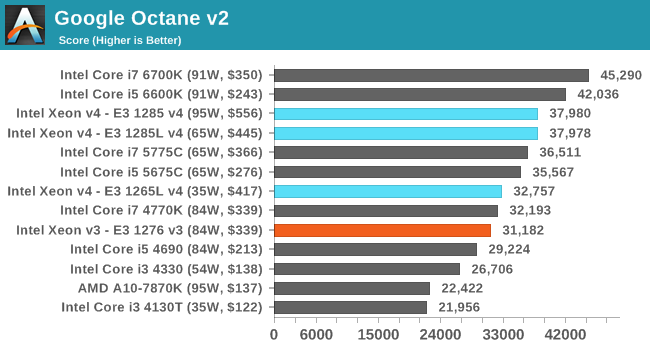
For web implementations, both Kraken and Octane see benefits moving up to Broadwell, but it is worth noting that moving to Skylake is an even better benefit. This again comes down to the management of CPU instructions between threads, and having benefits associated with keeping the knowledge of past instructions or information in lower cache levels. In would seem in this regard, if you count these benchmarks indicative of a real workload, that web-based throughput implementations are more in-flight operation limited than any other resource.










72 Comments
View All Comments
piasabird - Wednesday, August 26, 2015 - link
At $446 this isn't exactly an entry level CPU. I wonder where are the desktop CPU's with IRIS graphics like the i5-5575r which is suppose to be priced at $244 and available now but is not for sale anywhere?piasabird - Wednesday, August 26, 2015 - link
I guess Intel makes this processor but would rather have you buy a more expensive one. What is up with this? Same thing goes for i5-5675cdgingeri - Wednesday, August 26, 2015 - link
It's not meant to be a cheap CPU. It's a workstation/server chip. I has some additional data integrity features that the normal desktop CPUs can't use, like ECC memory. The drivers for the GPU are also optimized and tested for workstation level software, which is expensive to do. Sometimes, just frequency isn't enough.Camikazi - Friday, August 28, 2015 - link
I always wonder how people don't see that a server part is going to be more expensive than a desktop part. They always have been and always will be because they are binned higher and have additional features that desktops don't or can't use. Saying that $446 for this CPU is actually rather cheap for an entry level Xeon CPU and is not a bad price.Free008 - Tuesday, September 1, 2015 - link
Thats right it's too expensive. Intel will continue to gouge consumers with lower quality binned parts and disabled server features until Apple starts making decent desktop CPUs and then we can forever leave Intel and Microsoft at our leisure. Thats why none of the mobile Intel CPUs are selling - most the suppliers dont want to go back to the old monopoly days regardless of performance (which isn't incrementally significantly anymore anyway, just power savings). Intel thinks suppliers and consumers will put up with this forever but they are so wrong. It's just a matter of time now.zoxo - Wednesday, August 26, 2015 - link
It is rather disappointing that it seems that energy efficiency has regressed since the awesome 4790K. I was hoping that switching to 14nm would allow intel to do what the 88W 4790K could do in the 65W power envelope, but neither broadwell or skylake seems to be able to deliver that promise.mmrezaie - Wednesday, August 26, 2015 - link
I am also wondering why even though the performance is not changing that much but why power usage is not getting that much better!milkod2001 - Wednesday, August 26, 2015 - link
While CPU performance of the chip is only a little bit better, its GPU part is much bigger and performs much better, hence power consumption is the same as older chips. It's actually an achievement.For regular desktop CPUs i'd prefer Intel to give us native mainstream 6 core with no GPU at all.
But that would not played nicely with premium E series CPU. Money, money, money. Give me more :)
zoxo - Wednesday, August 26, 2015 - link
If you consider pure CPU loads, broadwell/skylake doesn't seem to show much power advantage over devil's canyon when you are getting to the 4GHz range. Skylake seems to be more overclock friendly, but it does consume a lot of power doing it.azazel1024 - Friday, August 28, 2015 - link
I was thinking the same thing based on Anandtech's original tests, but if you look at their notes under the delta power consumption and looking at a few other review sites, it looks a lot like motherboard manufacturers are all over the board with voltage/frequency curves for Skylake (and I assume here with Broadwell too) and it is biting them in the butt on power consumption. You've got a difference of easily 35% in power consumption from one board to the next using the same chip.Using the better numbers I have seen in some tests, Skylake, specifically the 6700k is actually significantly better than any other generation in performance per watt. Looking at the higher numbers in a few reviews, it is much worse than Broadwell and Haswell and only fractionally better than Ivy Bridge. I suspect that Skylake and probably Broadwell, that Intel's 14nm process has poor voltage/frequency scaling. Also that most motherboard manufactures are choosing poor voltage curves for the chip in an attempt to be extremely conservative.
A knock on effect here is, it is likely to be impacting actual performance too. If the 6700k has a TDP of 94w and the Dp is 110w...I'd half imagine that there is some throttling going on there with some loads.